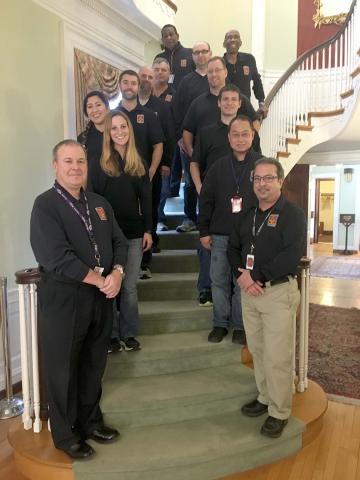Fire Marshal Oversees Safety Improvements

Working mostly unseen in the background for the past 31 years is NIH’s own fire prevention and protection organization—the Division of the Fire Marshal (DFM) in the Security and Emergency Response Program of the Office of Research Services. Many employees walk through buildings without realizing how many features are in place to protect them from a fire and how these features are installed and maintained.
Fire Marshal J.P. McCabe, with the support of several key managers, has grown DFM from a 2-person staff in 1987 to a 15-person team of fire safety professionals. He thought a comprehensive fire marshal operation, independent of facilities operations, would serve NIH’s mission best. DFM staff are available with one mouse click or phone call. They provide prevention, enforcement, engineering, education and investigation services at all NIH-owned campuses and facilities, as well as consultative services to leased facilities in Maryland.
DFM protects patients, employees, visitors and firefighters—a typical mission of any fire marshal operation. However, DFM is also charged with helping keep the Clinical Center accredited and protecting the biomedical research mission. Much equipment and many research animals at NIH are high-value and represent years of research data that would be difficult or impossible to replace. DFM tailors its operations and fire code provisions both to protect people and allow research and patient care to progress unimpeded.
DFM’s six fire protection engineers provide start-to-finish construction and renovation project services. Most are professional engineers. They are involved in project planning, design reviews at multiple stages, final permit review, shop drawing review and all construction-related inspections. Staffing levels provide a quick turnaround time to ensure that facilities can keep up with constant improvements, technological changes, new clinical trials and sudden, unexpected medical needs.
Existing buildings are the purview of DFM’s five fire prevention specialists/inspectors. They are involved with periodic building inspections, work permits, complaint investigation, public education and crowd control. Many buildings are old and contain mixed occupancies that are challenging from an enforcement standpoint.
McCabe and his staff have evaluated risk versus protection in all NIH buildings through the years. The most significant accomplishment has been the retrofit of most campus buildings with fire sprinkler systems. The antiquated campus telegraphic fire alarm reporting system has been fully replaced with a nearly completed, state-of-the-art mass notification system equipped to provide both fire reporting and two-way communication during any type of emergency.—Mat Chibbaro
